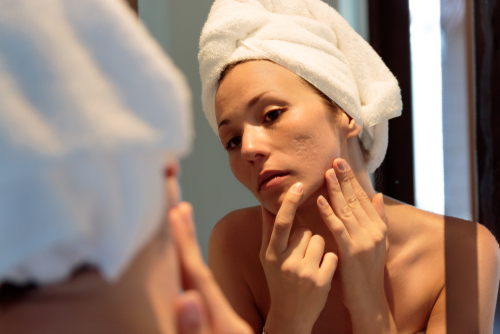Almost everyone can look back at a school picture where you had that huge zit on your face, but some of us have had acne throughout life that was much worse. Acne is a common skin condition that affects people of all ages.
It can range from mild to severe and can cause physical, psychological, and emotional distress. One of the most difficult aspects of acne is the scarring it can leave behind after the acne has cleared up. Severe acne can result in painful scarring that is hard to cover up with traditional makeup or creams.
Unfortunately, there aren’t very many options available at your local pharmacy that are strong enough to fight scars. With these lingering acne effects, it can be hard to maintain positive levels of self-confidence.
Since there are different types of acne scars, each with its own unique characteristics and treatments, the best treatment option starts with a consultation with a dermatologist or skin care professional. They will examine which scars you have and determine the best treatment or combination of treatments for your stubborn acne scars.
In this blog post, we will discuss the different types of acne scars, their causes, and treatment options at The Lett Center in Mt. Juliet & Lebanon, TN. When you receive the right treatment for your acne scars, you can gain your self-confidence back!
Types of Acne Scars

Keloid Scars
- Discolored
- Bumpy
- Raised areas of the skin
- Thick
Keloids are raised, thickened scars that occur when collagen production goes into overdrive. They are usually larger than the original wound or lesion and tend to be red or pink in color. They most commonly appear following an injury to the skin, such as surgery, a burn, or piercing. Keloids can also occur spontaneously. People with darker skin tones are more likely to develop keloids. Keloids can be itchy and uncomfortable, and they may interfere with movement if they form over a joint. Some people feel self-conscious about their appearance.
While keloids are not harmful, some people opt to have them removed for cosmetic reasons. Treatment options include cryotherapy, steroid injections, and surgery. Keloids can recur after treatment, so it’s important to work with a dermatologist or plastic surgeon who has experience treating them.
Rolling Scars
- Areas of skin that appear wavy
Rolling scars are a type of acne scar that can give your skin an uneven, wavy texture. They are characterized by shallow depressions in the skin with sloping edges that resemble rolling hills when viewed from above. Another reason they occur is from a burn. They’re caused by damage to the underlying skin tissue, which occurs when the collagen and elastin fibers that give your skin its structure are broken down. This usually happens as a result of inflammatory acne or excessive picking or squeezing of pimples, which can cause the bacteria to spread deeper into the skin and damage the tissue.
Rolling scars typically don’t respond well to topical treatments, so they may require more aggressive treatments, such as laser therapy or punch excisions. If you have rolling scars, it’s important to see a dermatologist so they can recommend the best treatment option for you. Dermal fillers may also be a good option to fill in the the areas of collagen loss.
Boxcar Scars
- Wavy skin texture with sharper edges
- Common on the face
- Cratershaped depressions
Boxcar scars are a type of atrophic scarring that commonly occurs on the face. These scars are characterized by sharply defined edges and a deep, crater-shaped depression. They can range in size from small to large and usually occur in clusters. Boxcar scars are most often caused by cystic and severe acne but can also be the result of trauma or surgery. Boxcar scars are a result of scar tissue being pulled down into the skin.
Treatment options for boxcar scars include dermal fillers, laser resurfacing, and microdermabrasion. In some cases, surgery may be necessary to remove the scar tissue. With proper treatment, boxcar scars can be significantly reduced, resulting in a more youthful appearance.
Icepick Scars
- Looks like a hole
- Narrow but penetrate deeply into the skin
Icepick scars are small, deep indent or divot scars that can occur as a result of an injury or acne. They are characterized by their narrow, tapered shape and their deep penetration into the skin. as a result of your skin losing collagen. As the skin above the affected areas collapses, it leaves what appears to be a hole. Icepick scars can be difficult to treat, but there are a number of options available. Dermal fillers can be used to plump up the skin and reduce the appearance of the scar. Laser resurfacing can also help to smooth out the texture of the skin and reduce the visibility of the scar. In some cases, surgery may be necessary to remove the scar completely. However, icepick scars are generally considered to be permanent. Therefore, it is important to consult with a healthcare professional before embarking on any treatment plan.
Hyperpigmentation
- Dark areas of skin
- Often caused by acne
Hyperpigmentation is not technically a scar, but very dark areas left behind by severe acne. Hyperpigmentation is a result of an overproduction of melanin in the affected area.
There are plenty of options available that can help reduce the appearance of your acne scars! You shouldn’t have to live with something that makes you feel so insecure or imperfect.
At The Lett Center for Plastic Surgery, we offer several different types of skin resurfacing procedures. These procedures are designed to help improve the appearance of your skin through a multitude of treatments that can significantly reduce lingering acne scars.

Why Treat Acne Scars
Severe acne can be an emotionally and physically taxing experience, resulting in depression and low self-esteem. Even after the acne is gone, the intense scarring that results remains as a permanent reminder of the battle. Thankfully, acne scars, which can be disfiguring and embarrassing, are treatable.
Acne Scar Treatment Options
Quadralase
Quadralase is a treatment option that utilizes minimally ablative laser skin resurfacing. It is newest fractional laser system available and can easily treat acne scarring with its innovative use combination of CO2 lasers and scanning systems. The two work together to help invigorate the skin and tighten the affected areas.
Vbeam
Vbeam is a vascular laser procedure that actually “takes the red out” of the affected areas of the face where scarring has occurred. This gentle yet effective treatment can help to reduce the appearance of scars by discouraging the formation of new collagen fibers and improving the quality of existing collagen. In addition, the VBeam can also help to improve skin elasticity and reduce inflammation. As a result, patients can enjoy smoother, softer, and more evenly-toned skin.
Microneedling
Another treatment option is microneedling. By using the MicroPen, microneedling treatments be adjusted to meet each patient’s individual needs, and it works to produce collagen and elastin in areas of the face that it is applied. Application can vary from patient to patient as treatments can take 1 or several visits per year. The treatment helps you feel more positive about your appearance by creating a fresh glow to your skin by fighting fine lines and acne scars.
Fractora
Fractora is a great option for patients with severe acne scarring. Fractora is an FDA-approved treatment for scars that uses radiofrequency energy to stimulate collagen production. The treatment can be used on both old and new scars, and it has been shown to be effective in reducing the appearance of acne scars, surgery scars, and trauma scars. Fractora can be performed as a standalone treatment or in combination with other scar treatments, such as laser therapy or injectable fillers.
How to Prevent Acne Scars
Taking care of your skin is essential to prevent acne scars. The first step to preventing scars is to treat acne. Wash your face with products that have salicylic acid, alpha hydroxy acids (AHAs), and lactic acids. These products are designed to thoroughly clear pores, exfoliate the skin, and reduce redness and swelling. However, since the products can be harsh, those with sensitive skin may want to try the product on a small area of skin first.
In addition, wear sunscreen when outdoors. Sunscreen helps maintain an even skin color; plus, UV rays can darken acne scars. By wearing an SPF, you can prevent your acne scars from becoming permanent. You can find facial products like moisturizers and serums with SPF in them. We sell plenty of high-quality skin care products online and in our store.
Keep Acne Scars at Bay and Boost Your Confidence!
One of the most important thing to note, however, is to take care of your skin as thoroughly as possible. If you are still dealing with severe acne, don’t take to bad habits like pimple popping and over washing to dry out your skin. You can consult your doctor to find ways to combat your current acne breakouts. The doctors at The Lett Center will help you find the best treatment for your acne scars.
Don’t let your acne scars or other facial features control your self-confidence! There are plenty of treatment options available to you right here at The Lett Center for Plastic Surgery. Contact us today at 615-443-0901 for more information or to setup a consultation!


